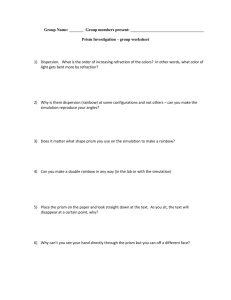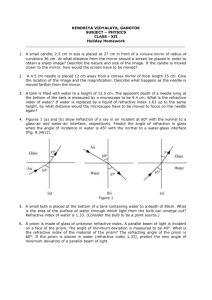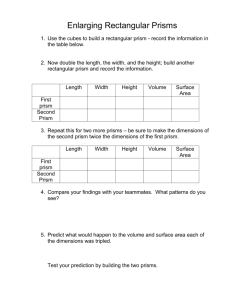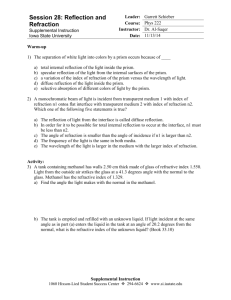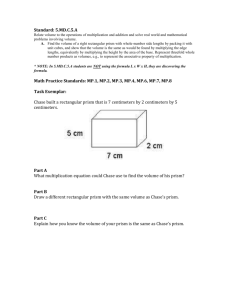Reflection, Refraction and the Prism
advertisement
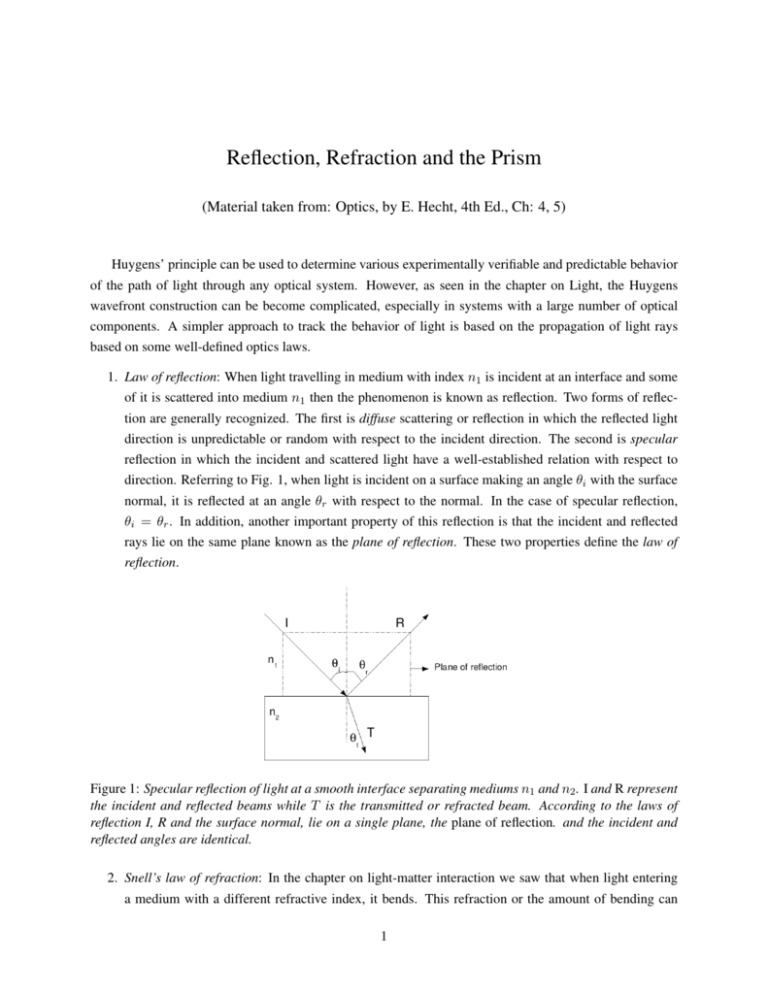
Reflection, Refraction and the Prism (Material taken from: Optics, by E. Hecht, 4th Ed., Ch: 4, 5) Huygens’ principle can be used to determine various experimentally verifiable and predictable behavior of the path of light through any optical system. However, as seen in the chapter on Light, the Huygens wavefront construction can be become complicated, especially in systems with a large number of optical components. A simpler approach to track the behavior of light is based on the propagation of light rays based on some well-defined optics laws. 1. Law of reflection: When light travelling in medium with index n1 is incident at an interface and some of it is scattered into medium n1 then the phenomenon is known as reflection. Two forms of reflection are generally recognized. The first is diffuse scattering or reflection in which the reflected light direction is unpredictable or random with respect to the incident direction. The second is specular reflection in which the incident and scattered light have a well-established relation with respect to direction. Referring to Fig. 1, when light is incident on a surface making an angle θi with the surface normal, it is reflected at an angle θr with respect to the normal. In the case of specular reflection, θi = θr . In addition, another important property of this reflection is that the incident and reflected rays lie on the same plane known as the plane of reflection. These two properties define the law of reflection. Figure 1: Specular reflection of light at a smooth interface separating mediums n1 and n2 . I and R represent the incident and reflected beams while T is the transmitted or refracted beam. According to the laws of reflection I, R and the surface normal, lie on a single plane, the plane of reflection. and the incident and reflected angles are identical. 2. Snell’s law of refraction: In the chapter on light-matter interaction we saw that when light entering a medium with a different refractive index, it bends. This refraction or the amount of bending can 1 Optics PHY 316 Refraction and the Prism be quantitatively estimated. by the Snell’s law. With reference to Fig. 2 a ray travelling in medium n1 is incident at an angle θi and is transmitted into medium n2 and at an angle θt with respect to the normal. Snell’s law defines the relation between the two angles for any pair of media as: n1 sinθi = n2 sinθt (1) Figure 2: Refraction of light and Snell’s law. Light incident at an angle θi at the interface separating two media n1 and n2 is transmitted into medium n2 at angle θt determined by Eq. 1. By the use of these simple laws and ray diagrams in combination with the laws of dispersion, numerous problems involving the passage of light through matter and through various optical components, like prisms, lenses, microscopes, telescopes, etc can be evaluated. We first discuss the interesting refractive and dispersive properties of a prism. 1 Prism Newton demonstrated in the 1600’s that white light passing though a prism could be separated into its different colors. While at that time he believed in the corpuscular theory of light, we know now that these individual colors represent different wavelengths or frequencies. From our introduction to refraction it is to be expected that light of different colors will bed through different angles. With reference to Fig. 3, white light travelling in medium n1 is incident at an angle θi1 to the normal of one face of the prism having refractive index n2 . A prism can serve many purposes, including as a dispersive element, a beamsplitter and a polarizing device. Here we discuss the behavior of a general dispersive prism. as shown in Fig. 3. The incident light is refracted at the first interface and travels at angle θt1 with respect to the normal. This light is incident at the second face of the prism at an angle θi2 and finally refracted again to exit the prism at angle θt2 . The various important angles in the ensuing discussion are: • Deviation angle D: This is defined as the angle between the original incident beam and the final transmitted beam. D = (θi1 − θt1 ) + (θt2 − θi2 ) 2 (2) Optics PHY 316 Refraction and the Prism Figure 3: White light incident on a dispersive prism is refracted and under certain conditions, its individual components can be seen. • Prism angle A: The apex angle of the prism is known as the prism angle. Referring to fig. 3 and using geometry we can relate D and A as follows: In polygon abcd, there are two right angles, ∠abc and ∠adc. Also for the polygon, since the sum of opposite angles should be 180o so: ∠bcd + ∠A = 180o (3) ∠bcd + θt1 + θi2 = 180o (4) Further, in triangle bcd we have: and therefore, from eq. 3 and 4 we have: ∠A = θt1 + θi2 (5) Therefore, using eq. 2 and 5, we can relate D and A as: D = θi1 + θt2 − A (6) Using these relations, you will perform various experiments and evaluation in experiment A3, i.e. the prism spectrometer, including, observing the dispersive properties of the prism, measurement of refractive index as a function of wavelength and the minimum deviation position for the prism. 1.1 Minimum deviation Dmin and refractive index of the prism When the prism is rotated perpendicular to the plane of incidence, i.e. such that the incidence angle θi1 is varied continuously, the deviation of the transmitted light changes. This deviation goes through a minimum Dmin . The measurement of this angle is useful as it leads to a simple relation between the refractive index n2 of the prism and easily measurable quantities like the prism angle A. This relation can be extracted on the basis of complicated math or by using simple physical arguments. Here we choose an argument based on symmetry. By symmetry we can argue that the minimum deviation position should be independent of the 3 Optics PHY 316 Refraction and the Prism Figure 4: Calculating the resolving power of a prism. The various angles, including the deviation angle (D) and prism angle (A) are indicated. direction in which light enters the prism. In other words, light entering the prism from the left or right should exhibit the same properties of refraction, minimum deviation, etc. Therefore, if we reverse the direction of new = θ old then θ new = θ old . light, thus having the new incident light θi1 t2 t2 i1 Experimentally it is observed that Dmin occurs when the refracted ray inside the prism makes equal angles with the two faces. This means that if we reverse the direction in which light is incident on the prism, we have a new θi1 = θt2 at which the Dmin occurs. However, experimentally, only one Dmin occurs and therefore: θi1 = θt2 at Dmin Using Snell’s law, we have: (7) n2 sinθi1 = n1 sinθt1 Using eq. 6 at minimum deviation we have: Dmin = 2θi1 − A or θi1 = Dmin + A 2 and from eq. 5 θt1 = A − θi2 and using the minimum deviation condition, eq. 7, we get: θt1 = A/2 with the result that the refractive index of an unknown prism can be obtained from: min sin( A+D2 n2 b = n1 sin A2 4 ) (8) Optics PHY 316 1.2 Refraction and the Prism Dispersion and resolving power As we know, n varies with ν (or λ) and the prism can be used to measure this variation or dispersion. A measure of how well the prism disperses the various wavelengths is known as the chromatic resolving power of the prism. Quantitatively it is defined as λ ∆λ where λ is any wavelength and ∆λ is a small difference centered around this wavelength. With reference to fig. 4, consider a parallel beam of white light (as will be the case from the collimator used in expt. A3) incident on the prism from the left. When the beam emerges on the right, any two components having wavelengths λ1 and λ2 will be separated by an angle ∆θ. For the rays emerging from the top of the prism, the difference in lengths travelled for the two colors is ∼ d∆θ and is mainly in the ambient medium. However, for the rays exiting from the bottom of the prism, the difference arises mainly because of travel through the length of the base of the prism b = 2LsinA/2. Now, since the optical path lengths of the two beams are different, so the difference at the bottom arises mainly sue to difference in the refractive indices of the two colors and therefore: b∆n = d∆θ (9) Now, the smallest resolvable angle, which will be quantitatively discussed under the topic of diffraction, is the diffraction limited angle given by: ∆θ = λ d where d is the size of the aperture (or the beam) used to make the measurement. Using the definition of the resolving power we get: λ ∆n dn A dn =b ∼b = 2Lsin( ) ∆λ ∆λ dλ 2 dλ (10) where the ratio of the small differences has been replaced by a derivative. Experimentally, the resolving power expressed by eq. 10 requires an estimate of rate of change of the R.I. with λ. While this can be done using the general form of the dispersion relation derived in the chapter on Light-matter interactions, a more useful empirical form was established by Augustin Cauchy and was given by: n=A+ B C + 4 + O(λ6 and higher) 2 λ λ Where, A, B, etc.. are Cauchy constants (not to be confused with the prism angle, etc..). In experiment A3, we will approximate n to the second power in λ thus giving: dn −2B = dλ λ3 5
